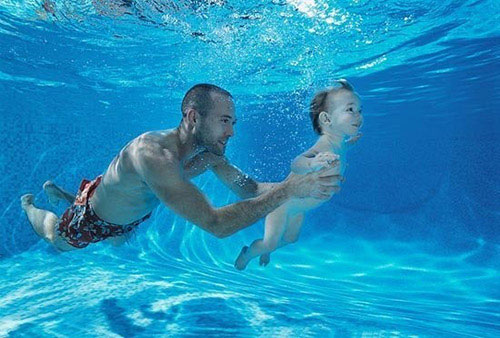Videos teaching babies to swim touch emotions
In Western countries, people are exposed to the pool very early. They have swimming classes for children 3 months and older. They even let the 7-day-old children go to the water. If you have small children, would you dare to do the same as them? Check out this clip!
Extremely hydrophilic activity for young children:
- Help develop physical, motor skills.
- Increase the height.
- Enhancing resistance, increasing nutrient absorption.
- Help your child to be independent and confident from a young age.
- For anorexia, slow growth, swimming in the water will help your baby eat more and sleep better.

In Vietnam, parents are often afraid to let their children go to the pool for fear of cold, fear of sickness, fear that they cannot breathe under water. But actually, since she was in her mother's womb, she was swimming in the water. So when I went to the country, I had the instinct to swim by myself. If you don't help your child remember this instinct, after 2 years it will go away on its own.
Infants have a specific swimming style based on the genetic innate reflexes of mammals. It is the reflex that closes the trachea cap when the head sinks into the water and the reflexes scare the arms and legs to swim in the water. In the young country, the eyes can be opened without discomfort.
Therefore, in the West, people have exposed children to water very early. In Vietnam, due to the small pool conditions, as well as the absence of swimming classes for babies, many older children still cannot swim. But parents can remedy this by buying a pontoon, or giving them away to the public swimming pools early and following the way of the parents in the clip below (note: choose clean swimming pools) will prevent pinkeye).
- Monkey learns to swim like people
- Why don't you learn how to swim forever?
- 5 'deadly' emotions that we should avoid
- What is Touch ID? How does Touch ID work?
- Will babies who breastfed out be better?
- Dogs can really understand people's emotions
- Beautiful people swim with sharks
- Turn on the wood touch sensor
- New discovery of human touch
- Classify 4 types of true emotions on the human face
- Google spent $ 1.5 million to study methods for learning robots like babies
- Dolphins cannot swim too fast
 Why does steam cause burns worse than boiling water?
Why does steam cause burns worse than boiling water? Lightning-fast octopus is amazing
Lightning-fast octopus is amazing Video: The secret to quickly fold clothes in just 2 seconds for busy people
Video: The secret to quickly fold clothes in just 2 seconds for busy people The eel waving off his head still bites the can of water
The eel waving off his head still bites the can of water